You are using an out of date browser. It may not display this or other websites correctly.
You should upgrade or use an alternative browser.
You should upgrade or use an alternative browser.
Weekly Flag Challenge: Discussion & Entries
- Thread starter Transparent Blue
- Start date
Also an earlier post said this was going to go till next Tues...
OK then, but it should be updated to the 13th if we're really prolonging it. You'll have to ask Richard about this.
Well, the challenge said:
So surely it should be up for voting by now.
Code:
Closing time for entries = 6th November, 12 midnight GMT
Voting to end at 13th November, 12 midnight GMT.Ok, so I made the flag last night and was getting ready to upload it when my computer died... For now here is the flag, I'll upload the story later after I rewrite it (I lost it when the computer died...)
Not to nitpick, but you could have scaled down that flag to make it a bit smaller. It's gigantic and hard to view in a single post.
Sorry, I didn't realize how big it was until I uploaded it, and didn't have time to do anything about it, as I needed to leave for class... I'll see what I can do about scaleing it down...Not to nitpick, but you could have scaled down that flag to make it a bit smaller. It's gigantic and hard to view in a single post.
Edit: Fixed...
Last edited:
I've started a voting thread here:
https://www.alternatehistory.com/discussion/showthread.php?p=6889892&posted=1#post6889892
Please let me know if I haven't done it correctly.
https://www.alternatehistory.com/discussion/showthread.php?p=6889892&posted=1#post6889892
Please let me know if I haven't done it correctly.
I've started a voting thread here:
https://www.alternatehistory.com/discussion/showthread.php?p=6889892&posted=1#post6889892
Thanks. I'll add the link to the overview page.
Please let me know if I haven't done it correctly.
I think it's all right, nothing really deviating from the established practice. Loving the pun in the round's title.
Congratulations to The Professor for winning Challenge 80 with this flag:

Over to you Professor for Challenge 81!
Over to you Professor for Challenge 81!
Congratulations to The Professor for winning Challenge 80 with this flag:

Over to you Professor for Challenge 81!
Thank you.
I'll stick this in the Winners & Challenges Thread since I have one ready
Any timeframe limitations?
Nope, can be at any point inan ATL.
A good point that I'll update!
Hi everybody,
Attached below, you can see my attempt for the "Flanders-Normandy" flag. I hope you like it!
Symbolism of the flag
The black in the flag represents the misery and trouble the region suffered and endured. Yellow represents the peace and it is both the colour of Normandy and Flanders. The two stars symbolise the Federation of United Flanders and Normandy; the two regions it comprises. They are red, which is a symbolic colour of Normandy, as well as a colour that indicates blood and war. Additionally, the dove with the laurel wreath is a pace sign, and the laurel wreath is green, symbolising the area's nature and green fields and meadows.
Brief history
The Federation of United Flanders and Normandy
After World War I, which devastated the regions of Normandy, Brittany and Flanders, as well as Cornwall and Wales, the Federation of United Flanders and Normandy was established. This buffer state was created, between France and the Netherlands, to prevent any disputes between the world powers France, the Netherlands and the German Empire from happening again in the future.
The German Empire, which comprised southern German states, such as Bavaria and Tyrol, as well as Nordic states, like Lapland, Norway and Sweden, and all other Germanic areas, had lost millions of soldiers in the war in the east against Muscovy. As a result of this, the war at the western front had been a disaster. Desperately, afraid of losing territory in the west, Germany started the fearsome bombardments of Cornish and Welsh cities and gas bombings of Brittany, Normandy's coast and the entire Flanders Fields. All this, was the idea of the German general Klaus, who was executed after the war.
In an attempt to stop this inhumane events, Britain quickly started negotiations. As a compromise, much of the German lands was fragmented into small nation-states. About the same happened with Britain, giving Wales, Scotland, Ireland and Cornwall independence. Flanders and Normandy were made one state and its economy was boosted by US loans. The US and Canada, namely, were the two world powers that intervened and at the same time forced Great Britain, France, Germany, Muscovy and the Hungarian Kingdom to negotiate.
Please give comments!

Attached below, you can see my attempt for the "Flanders-Normandy" flag. I hope you like it!
Symbolism of the flag
The black in the flag represents the misery and trouble the region suffered and endured. Yellow represents the peace and it is both the colour of Normandy and Flanders. The two stars symbolise the Federation of United Flanders and Normandy; the two regions it comprises. They are red, which is a symbolic colour of Normandy, as well as a colour that indicates blood and war. Additionally, the dove with the laurel wreath is a pace sign, and the laurel wreath is green, symbolising the area's nature and green fields and meadows.
Brief history
The Federation of United Flanders and Normandy
After World War I, which devastated the regions of Normandy, Brittany and Flanders, as well as Cornwall and Wales, the Federation of United Flanders and Normandy was established. This buffer state was created, between France and the Netherlands, to prevent any disputes between the world powers France, the Netherlands and the German Empire from happening again in the future.
The German Empire, which comprised southern German states, such as Bavaria and Tyrol, as well as Nordic states, like Lapland, Norway and Sweden, and all other Germanic areas, had lost millions of soldiers in the war in the east against Muscovy. As a result of this, the war at the western front had been a disaster. Desperately, afraid of losing territory in the west, Germany started the fearsome bombardments of Cornish and Welsh cities and gas bombings of Brittany, Normandy's coast and the entire Flanders Fields. All this, was the idea of the German general Klaus, who was executed after the war.
In an attempt to stop this inhumane events, Britain quickly started negotiations. As a compromise, much of the German lands was fragmented into small nation-states. About the same happened with Britain, giving Wales, Scotland, Ireland and Cornwall independence. Flanders and Normandy were made one state and its economy was boosted by US loans. The US and Canada, namely, were the two world powers that intervened and at the same time forced Great Britain, France, Germany, Muscovy and the Hungarian Kingdom to negotiate.
Please give comments!
During World War 2, the lands bordering the shores of the atlantic were heavily militarised by the german who finaly detached them from their former countries but to better control the local population, these were presented as "autonomous protectorates" and not (in theory) annexed to germany.
Shown here is the flag of one such, the Reichsprotektorat Normandie-Flandern.

Shown here is the flag of one such, the Reichsprotektorat Normandie-Flandern.
Nope, can be at any point inan ATL.
A good point that I'll update!
Further question - does it have to be de jure rule of the regions, or can the state be based in part of the area but undertake an occupation of the rest? Also, does the entry flag have to be the national flag, or can it be a flag of the nation?
Last edited:
The Grand Duchy of Normandy-Flanders was formed out of the eastern portion of the British Occupation Zone, after disputes broke out among the victorious Great Powers (Great Britain, Austria, Italia, Iberia, Poland and Canada) over the interpretation of the Treaty of Madrid, marking the final defeat of the Empire of Franco-Germania. To the general surprise of all parties, the Grand Duchy and the other Franco-German successor states hurriedly set up as the provisions of the Treaty were ignored, flouted, or irrationally adhered to (depending upon who was doing the interpretation) have been at peace with themselves and their neighbors for over fifty years, and their governments have been surprisingly stable.

Competition Entry flag: First Regimental.
In 1758, the Third Treaty of Versailles excludes the possibility of a Southern Netherlands state ruled by the Duke of Parma. Instead, in 1763, Emperor Francis I installs his eldest and favourite daughter, Archduchess Maria Anna, as ruler of the region, to follow her mother's footsteps as an independent ruler. She was accompanied by her sister Archduchess Maria Elisabeth, and they effectively shared rulership of the state of the Burgundian Netherlands (Burgundian here being a reference to the Burgundian Circle). Archduchess Maria Anna took a consort, preserving the Habsburg line, and bore two children: Francis Peter / Frans Pieter (1766) and Frances Maria / Fransiska Maria (1769). Francis Peter took the throne of Archduke of the Burgundian Netherlands upon his mother's death in 1789, and was ruler when the French Revolution broke out. He allied with the First Coalition, and was, with support from French Loyalists and the British, able to advance along the Channel coastline, liberating Artois, Picardy, Eu and Normandy, but was unable to link up with the Loyalist forces in Vendée and Brittany. As the war continued, French successes forced Burgundian troops out of France, and Burgundy itself was invaded in Spring of 1794. The Burgundian forces fought valiantly but were overwhelmed by the French, and the Archduke was captured and executed at the direction of the Committee of Public Safety. Archduchess Frances Maria escaped capture, and took refuge in Britain for the course of the Revolutionary and Napoleonic Wars, through which Burgundian forces fought alongside the British. Following the war, Burgundy was re-established, with the additions of the Principality of Liège and of Artois, with the Archduchess acting as regent for her brother's only child, Charles Francis.
Flag of the Burgundian Netherlands/Burgundy:

Regimental Colours of the Revolutionary and Napoleonic Wars:
Burgundian:
Colour of the First Regiment of the Duchy of Brabant:
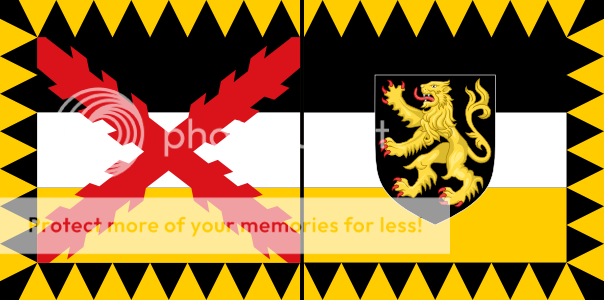
Colour of the Second Regiment of the County of Hainaut:
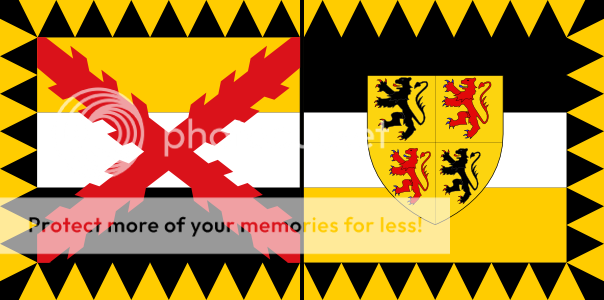
Colour of the Third Regiment of the County of Flanders:
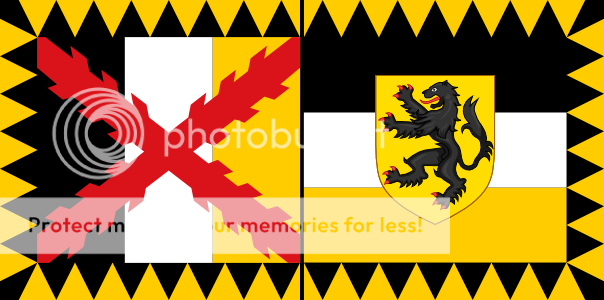
Colour of the Fourth Regiment of the Duchy of Luxemburg:
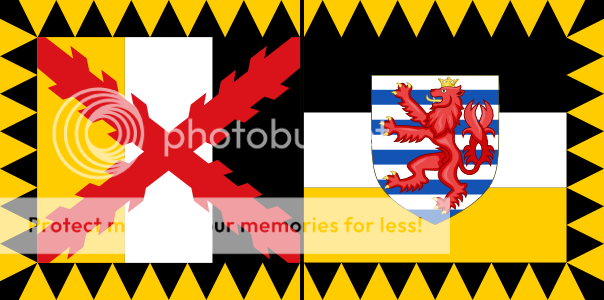
Colour of the Fifth Regiment of the County of Namur:
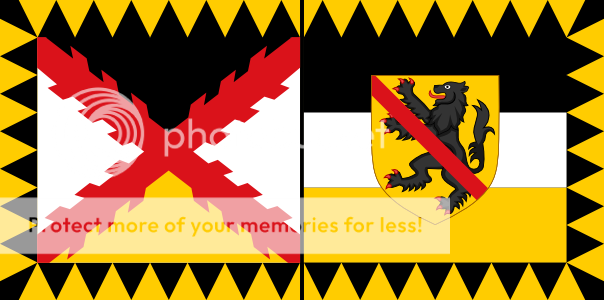
French Loyalists under the Burgundian flag:
Colour of the First Regiment from Artois:
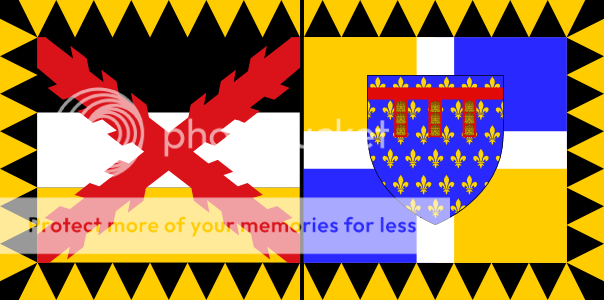
Colour of the First Regiment from Normandy:
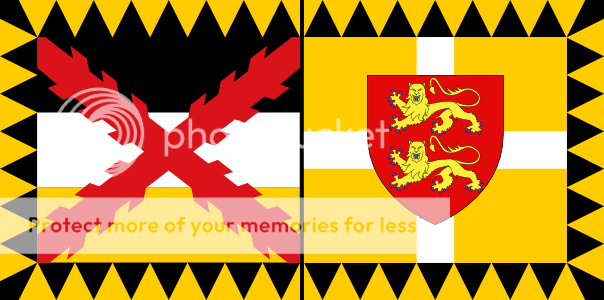
In 1758, the Third Treaty of Versailles excludes the possibility of a Southern Netherlands state ruled by the Duke of Parma. Instead, in 1763, Emperor Francis I installs his eldest and favourite daughter, Archduchess Maria Anna, as ruler of the region, to follow her mother's footsteps as an independent ruler. She was accompanied by her sister Archduchess Maria Elisabeth, and they effectively shared rulership of the state of the Burgundian Netherlands (Burgundian here being a reference to the Burgundian Circle). Archduchess Maria Anna took a consort, preserving the Habsburg line, and bore two children: Francis Peter / Frans Pieter (1766) and Frances Maria / Fransiska Maria (1769). Francis Peter took the throne of Archduke of the Burgundian Netherlands upon his mother's death in 1789, and was ruler when the French Revolution broke out. He allied with the First Coalition, and was, with support from French Loyalists and the British, able to advance along the Channel coastline, liberating Artois, Picardy, Eu and Normandy, but was unable to link up with the Loyalist forces in Vendée and Brittany. As the war continued, French successes forced Burgundian troops out of France, and Burgundy itself was invaded in Spring of 1794. The Burgundian forces fought valiantly but were overwhelmed by the French, and the Archduke was captured and executed at the direction of the Committee of Public Safety. Archduchess Frances Maria escaped capture, and took refuge in Britain for the course of the Revolutionary and Napoleonic Wars, through which Burgundian forces fought alongside the British. Following the war, Burgundy was re-established, with the additions of the Principality of Liège and of Artois, with the Archduchess acting as regent for her brother's only child, Charles Francis.
Flag of the Burgundian Netherlands/Burgundy:

Regimental Colours of the Revolutionary and Napoleonic Wars:
Burgundian:
Colour of the First Regiment of the Duchy of Brabant:

Colour of the Second Regiment of the County of Hainaut:

Colour of the Third Regiment of the County of Flanders:

Colour of the Fourth Regiment of the Duchy of Luxemburg:

Colour of the Fifth Regiment of the County of Namur:

French Loyalists under the Burgundian flag:
Colour of the First Regiment from Artois:

Colour of the First Regiment from Normandy:

Last edited:
Share:

